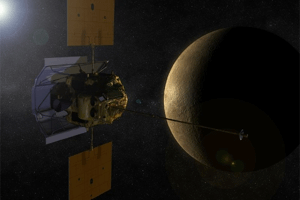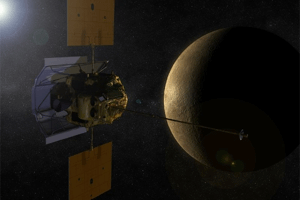At first glance, Mercury presents the appearance of Earth's Moon, but doing just a little math tells you there's more to it. Just divide its mass by its volume and you get 5.43 grams per cubic centimeter—Mercury's average density. That's only a shade less than Earth's average density of 5.51 g/cc, which indicates that Mercury contains more heavy elements than the Moon—elements like iron, for example. (Personally, I suspect there's gold on that thar planet, too….) In fact, after Earth, Mercury is the densest known planet in the solar system. What does it hide under that cratered and radiation-baked surface?
An interesting tidbit about Mercury: because of its high density—because of the amount of material packed within its smallish confines—the surface gravity on Mercury is about the same as on Mars, even though Mars is larger. (Mercury has a diameter of just over 3000 miles, while Mars is about 4200 miles across.) On both worlds, you'd weight about 38% what you weigh on Earth.
And now, Mercury has joined a new club: planets that have been orbited by spacecraft—in this case, NASA's MESSENGER. MESSENGER has been en route to its final orbit around Mercury for over six and a half years. Since its launch on August 3, 2004, MESSENGER has been winding its way through the inner solar system, swinging back past Earth about a year after launch, making a couple of close passes by Venus, then three fly-bys of Mercury itself, before settling into orbit on March 17th.
This long and meandering path was a great fuel saver: by making flybys of planets, MESSENGER's trajectory and speed were altered to make the transition from Earth orbital velocity to a stable orbit around Mercury without burning a lot of fuel to do so. Other spacecraft have used gravitational "slingshot" maneuvers to change direction or gain speed for free, including the Voyagers and New Horizons (on its way to Pluto).
At Mercury, sunlight is up to ten times more intense than at Earth—and since Mercury has no atmosphere to filter out ultraviolet and X-rays, let's just say the sunburn you'd get standing on its surface would be nothing short of lethal. Never mind the lack of air….
To keep cool in the intense solar radiation environment around Mercury, MESSENGER takes advantage of the same physical principle that keeps the dark side of Mercury itself cool (as cold as negative 185 degrees F): insulation. Down on Mercury, the night-time surface is protected from the Sun's intense rays by an entire planet of material. With no atmosphere to trap heat, at night the temperature plummets as heat radiates from rocks and soil directly into space.
MESSENGER possesses a shield: a "sun screen" made of heat-resistant ceramic cloth, situated between the Sun and spacecraft much like someone holding a parasol to stay in the shade.
Poking out from behind its shield, MESSENGER wields two solar panels that provide the spacecraft all of its power—one distinct advantage of the otherwise troublesome intensity of Mercurial sunlight.
Now that MESSENGER is in orbit, what do we hope to discover in the days and months ahead?
Is there ice at the bottom of polar crater floors? How is Mercury's magnetic field generated? Does Mercury have, or did it have, plate tectonics? What's it made of? How does Mercury interact with plasma flowing from the Sun—the solar wind? Are there any strange obelisks on its surface? …to make just a partial list…. Answers to follow (for most of them, anyway).
37.8148 -122.178
 Artist concept of MESSENGER arriving at Mercury.
Artist concept of MESSENGER arriving at Mercury. 